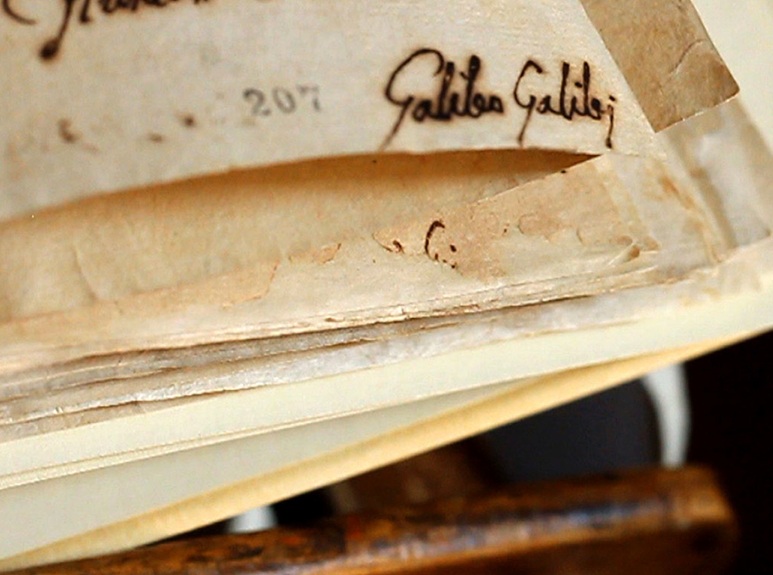BLOG
THE GALILEO GALILEI MANUSCRIPT

On June 22nd 1633, the Cardinals part of the Inquisition have sentenced Galileo Galilei - the most famous scientist of Europe. They accused him of making up the heliocentric theory, stating that the Sun was not moving and it was the center of the Universe, and the planets are moving around it. His theory was explained in his new book "Dialogue concerning the two chief world systems", publish in Florence in 1632.
During that warm morning, I found myself in front of an historical palace, close to the Pantheon, waiting in line to visit a special library, part of a government institution. I was looking forward to this visit for a long time, and I could not wait to see the thousands of old manuscripts and archives, unique in the world. After half an hour of waiting, and after passing through very rigors security, our guide lead us through a labyrinth of hundreds of old books, conference rooms and archives. During that visit I found out that the building had a great historical importance of over 2000 years, and used to be the Dominican monastery and the main office of the Holly Office, the Inquisition Court. Afterwards, during the next few centuries, the building hosted one of the Italian Government branches. Here, the Inquisition Cardinals would get together three times a week for trials, and in June 22, 1633 they sentenced Galileo Galilei. The Dominican monks, were called "l'Ordo Predicatorum", and were educated people that were in charge with communicating the Church's message to the masses; think of them like today's PR professionals. The committee of the Holly Office, formed by Cardinals and high level Ecclesiastes , had the mission of watch out for the books considered to be against the church, which afterwards were put on a list of prohibited reading.
While visiting the historical building with original antique furniture from the 800s, you could feel the atmosphere of the time passed, while the bolted windows created a surreal calm. Even though we were on the first floor, you could not even hear the noises made by the chariots pulled by horses galloping on the “sanpietrini” ( the typical black basalt stones pavement ) and entering the famous historical streets of Rome. All around you could feel the astonishing silence, while stepping on the thick red carpets, and while being surrounded by wooden shelves full of thousands and thousands of books, perfectly aligned. We passed through room after room, archive after archive, until we finally found our way to a room where old, historical manuscripts found a home.
While I got closer and closer to be able to read the titles of the manuscripts, all of a sudden, I could not believe my eyes. In that same room, there was exposed a small book, covered in leather and put together by hand. Right there, in front of my eyes, there was the original manuscript of Galileo Galilei. His most famous book, where he demonstrated his studies, which created such a big controversy during that time, giving birth to one of the most controversial trials in history. For me, it was an unbelievable emotion. I have only experienced such an emotion while I was visiting the Vatican's Secret Archive when they opened an antique drawer, and I found myself in front of a secret document holder from the time of Henry VIII of England, containing 81 seals. Galileo's whole life was marked by the publication of this volume, and what was surprising to me was that this book, along other "prohibited" books, were not destroyed, but kept with great secrecy under lock. Due to that, we have the opportunity nowadays to marvel in front of his genius work. Being afraid that he was going to have the same faith as Giordano Bruno few years earlier, Galileo abandoned his studies. The many interrogations that he was subjected to and his failing health also contributed to him abandoning his work.
However, the surprises did not end there; after crossing a monumental corridor, we get to a small room, resembling a cell, where there was a small desk and a wooden chair. There, in that cell, in June 22, 1633, stood Galileo, waiting on his conviction. We can only imagine the tension in that cell during that day. From there, he was taken into a different room, where he had to kneel and listen to his sentence. In front of the Holly Inquisition, a little later, during the XVII century, it was told that Galileo was the one who said the famous phrase: "And yet, it moves!"; in reference to the Earth moves around the Sun, according to Nicolaus Copernicus's theory, which he defended in his book. In the famous painting we can see a strong and resourceful Galileo, but we know now that the reality was different. We know now how his story ended: he lived briefly in Rome, in the Trinità dei Monti neighborhood, then moved to Siena, and finally, he retired in the country, close to Florence. He spent his last days there until he died of old age in 1642, 11 years after the trial. His legacy as an inventor, scientist, mathematician and astronomer is priceless. He was laid to rest in Florence, at Santa Maria Novella, where another genius is buried, Michelangelo. But not even there was he given a special burial because the Inquisition refused to allow that privilege to a man accused of heresy.
We have been there for a couple of hours when we entered this fascinating place full of history, and we walked through hallways and corridors leading us back to the times of the Dominicans. But this is another story, which I will tell you about some other time. Stay tuned! We will talk again soon!

